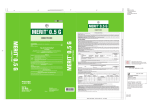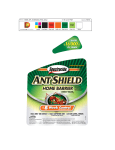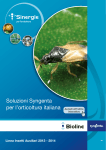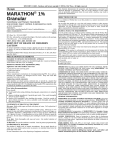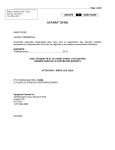Download Allectus G insecticide specimen label
Transcript
G Insecticide Specimen Label * For general insect control in turfgrass areas including athletic fields and parks and residential, commercial, industrial, institutional, and recreational lawns. Not for use on golf courses or sod farms. ACTIVE INGREDIENT: Imidacloprid*, 1-[(6-Chloro-3-pyridinyl)methyl]-N-nitro-2-imidazolidinimine . . . . .0.20% Bifenthrin** . . . . . . . . . . . . . . . . . . . . . . . . . . . . . . . . . . . . . . . . . . . . . . . . . . . . . . .0.16% OTHER INGREDIENTS: . . . . . . . . . . . . . . . . . . . . . . . . . . . . . . . . . . . . . . . . . . . . . . . 99.64% TOTAL . . . . . . . . . . . . . . . . . . . . . . . . . . . . . . . . . . . . . . . . . . . . . . . .100.00% * Protected by U.S. Patent No. 4,742,060 **Cis isomers 97% minimum, trans isomers 3% maximum. Bifenthrin: U.S. Patent No. 4,238,505 EPA Reg. No. 432-1407 EPA Est. No. (75)=5905-GA-1, (46)=5905-IA-1, (89)=9198-AL-01 STOP - Read the label before use. KEEP OUT OF REACH OF CHILDREN CAUTION FOR MEDICAL AND TRANSPORTATION EMERGENCIES ONLY CALL 24 HOURS A DAY 1-800-334-7577 FOR PRODUCT USE INFORMATION CALL 1-800-331-2867 FIRST AID If swallowed • • • • • • • • Call a poison control center or doctor immediately for treatment advice. Have person sip a glass of water if able to swallow. Do not induce vomiting unless told to do so by a poison control center or doctor. Do not give anything by mouth to an unconscious person. If on skin Take off contaminated clothing. Rinse skin immediately with plenty of water for 15 to 20 minutes. Call a poison control center or doctor for treatment advice. If in eyes Hold eye open and rinse slowly and gently with water for 15 to 20 minutes. Remove contact lenses, if present, after the first 5 minutes, then continue rinsing eye. • Call a poison control center or doctor for treatment advice. In case of emergency call toll free the Bayer Environmental Science Emergency Response Telephone No. 1-800334-7577. Have a product container or label with you when calling a poison control center or doctor, or going for treatment. Note To Physician: No specific antidote is available. Treat the patient symptomatically. This product contains a pyrethroid. If large amounts have been ingested, milk, cream and other digestible fats and oils may increase absorption and so should be avoided. NET CONTENTS: 50 lbs PRECAUTIONARY STATEMENTS HAZARDS TO HUMANS AND DOMESTIC ANIMALS CAUTION: Harmful if swallowed or absorbed through skin. Causes moderate eye irritation. Avoid contact with skin, eyes, or clothing. Wash thoroughly with soap and water after handling and before eating, drinking, chewing gum or using tobacco. Remove and wash contaminated clothing before reuse. Personal Protective Equipment (PPE) Applicators and other handlers must wear: • Long-sleeved shirt and long pants • Shoes plus socks Follow manufacturer’s instructions for cleaning/maintaining PPE. If no such instructions for washables, use detergent and hot water. Keep and wash PPE separately from other laundry. User Safety Recommendation: Users should: • Wash hands before eating, drinking, chewing gum, using tobacco or using the toilet. • Remove clothing immediately if pesticide gets inside. Then wash thoroughly and put on clean clothing. • Remove PPE immediately after handling this product. Wash the outside of gloves before removing. As soon as possible, wash thoroughly and change into clean clothing. ENVIRONMENTAL HAZARDS This product is extremely toxic to fish and aquatic invertebrates. Do not apply directly to water, or to areas where surface water is present or to intertidal areas below the mean high water mark. Do not contaminate water when disposing of equipment washwater or rinsate. Run-off may be hazardous to aquatic organisms in water adjacent to treated areas This product contains a chemical with properties and characteristics associated with chemicals detected in groundwater. The use of this chemical in areas where soils are permeable, particularly where the water table is shallow, may result in groundwater contamination. DIRECTIONS FOR USE It is a violation of Federal law to use this product in a manner inconsistent with its labeling. Do not apply this product in a way that will contact workers or other persons, either directly or through drift. Only protected handlers may be in the area during application. For any requirement specific to your State or Tribe, consult the agency responsible for pesticide regulation. Do not formulate this product into other end-use products. STORAGE AND DISPOSAL Do not contaminate water, food, or feed by storage or disposal. Pesticide Storage: Store in a cool, dry place and in such a manner as to prevent cross contamination with other pesticides, fertilizers, food, and feed. Store in original container and out of the reach of children, preferably in a locked storage area. Handle and open container in a manner as to prevent spillage. If material is spilled for any reason or cause, carefully contain any spilled material to prevent non-target contamination. Do not walk through spilled material and dispose of as directed for pesticides above. Refer to Precautionary Statements on label for hazards associated with the handling of this material. In spill or leak incidents, keep unauthorized people away. You may contact the Bayer Environmental Science Emergency Response Team for decontamination procedures or any other assistance that may be necessary. The Bayer Environmental Science Emergency Response Telephone No. is 1-800-334-7577 or contact Chemtrec at 800424-9300. Pesticide Disposal: Wastes resulting from the use of this product may be disposed of on site or at an approved waste disposal facility. Container Disposal: Completely empty bag into application equipment. Dispose of empty bag in a sanitary landfill, by incineration, or if allowed by the state and local authorities, by burning. If burned, stay out of smoke. GENERAL INFORMATION APPLICATION TO TURFGRASS Allectus G Insecticide can be used for the control of soil inhabiting pests of turfgrass, such as northern and southern masked chafers, Cyclocephala borealis, C. immaculata, and/or C. lurida; Asiatic garden beetle, Maladera castanea; black vine weevil, Otiorhyncus sulcatus, European chafer, Rhizotroqus majalis; green June beetle, Cotinis nitida; May or June beetles, Phyllophaga spp.; Japanese beetle, Popillia japonica; oriental beetle, Euetheola humulis rugiceps; billbugs, Sphenophorus spp.; annual bluegrass weevil, Hyperodes spp.; black turfgrass ataenius, Ataenius spretulus; Aphodius spp; European crane fly, Tipula paludosa; frit fly, Oscinella frit; chinch bugs, Blissus spp.; fire ants, Solenopsis spp.; cutworms, Agrotis ipsilon, Peridroma saucia, Nephalodes menians; armyworms, Spodoptera spp., Pseudaletia spp.; sod webworm, Crambus spp.; and mole crickets, Scapteriscus spp. Allectus G can be used as directed on turfgrass in sites such as home lawns, business and office complexes, shopping complexes, multi-family residential complexes, airports, cemeteries, parks, playgrounds, and athletic fields. The active ingredients Allectus G have sufficient residual activity so that applications for control of subsurface feeders can be made preceding the egg laying activity. The need for an application for control of subsurface feeders can be based on historical monitoring of the site, previous records or experiences, current season adult trapping or other methods. Optimum control of subsurface feeders will be achieved when applications are made prior to egg hatch of the target pest, followed by sufficient irrigation or rainfall to move the active ingredient through the thatch. The active ingredients in Allectus G have sufficient knockdown and residual activity to provide curative and residual control of surface feeding pests. Applications for control of surface feeding pests can be made when infestations are anticipated based on historical monitoring of the site, previous records or experience, current season adult trapping or presence of insects at economic thresholds as determined by scouting and/or recommendations of local State extension personnel or other qualified specialists. Do not apply more than 125 lb of Allectus G (0.25 lb of imidacloprid, 0.2 lb bifenthrin) per acre per application on residential use sites (i.e., around private homes, apartment buildings, condominiums, non-agricultural outbuildings, non-commercial greenhouses, pre-schools or day care facilities). May be applied at up to 250 lb of Allectus G (0.5 lb of imidacloprid, 0.4 lb bifenthrin) per application on non-residential use sites (i.e., around institutional, public, commercial or industrial buildings; parks; recreational areas or athletic fields). Applications should not be made when turfgrass areas are waterlogged or the soil is saturated with water. Adequate distribution of the active ingredient cannot be achieved when these conditions exist. The treated turf must be in such a condition that the rainfall or irrigation will penetrate vertically in the soil profile. Total amount applied cannot exceed a total of 250 lb (0.5 lb of imidacloprid, 0.4 lb of bifenthrin) per acre per year. NOTE: Not for use in commercial greenhouses or on grass grown for seed or on golf courses and sod farms. For use on plants intended for aesthetic purposes or climatic modification and being grown in interior plantscapes, ornamental gardens or parks, or on lawns and grounds. APPLICATION EQUIPMENT Apply Allectus G uniformly over the area being treated with normally used granular application equipment. Both drop-type and rotary-type spreaders may be used to apply Allectus G. Avoid the use of spreaders that apply the material in narrow, concentrated bands. Calibrate application equipment prior to use according to the manufacturer’s directions. Check frequently to be sure equipment is working properly and distributing granules uniformly and accurately. CROP RECOMMENDED APPLICATIONS (Be sure to read "APPLICATION EQUIPMENT" Section of this label) PEST Turfgrasses DOSAGE Allectus G Insecticide 100 to 125 lb per acre (2.3 to 2.9 lb per 1000 sq ft) Larvae of subsurface feeders: Green June beetle Asiatic garden beetle Japanese beetle Black turfgrass ataenius Northern masked chafer Black vine weevil Oriental beetle European chafer Phyllophaga spp. European crane fly Southern masked chafer Adults and/or larvae of subsurface and surface feeding pests: 125 lb per acre Imported Fire ants1 (2.9 lb per 1000 sq ft) Mole crickets2 or Pillbugs for heavy infestations, a single annual Sowbugs application of 200 to 250 lb per acre Millipedes (4.6 to 5.7 lb per 1000 sq ft) Adults and/or larvae of surface feeders: 75 to 125 lb per acre Annual bluegrass weevil Frit fly (1.7 to 2.9 lb per 1000 sq ft) Billbugs Leafhoppers Chinch bugs Mealybugs Nuisance ants Larvae of surface feeders: 50 to 125 lb per acre Armyworm Sod webworms (1.2 to 2.9 lb per 1000 sq ft) Cutworm Consult your local State Agricultural Experiment Station, or State Extension Turf Specialists for more specific information regarding timing of application. NOTE: For optimum control, irrigation or rainfall should occur within 24 hours after application to move the active ingredient through the thatch. Avoid mowing turf or lawn area until after irrigation or rainfall has occurred so that uniformity of application will not be affected. In New York State, this product may NOT be applied to any grass or turf area within 100 feet of a water body (lake, pond, river, stream, wetland, or drainage ditch). In New York State, do make a single repeat application of ALLECTUS G if there are signs of renewed insect activity, but not sooner than two weeks after the first applications. 1 Imported Fire ants: Allectus G may be applied as a broadcast treatment at 2.9 lb. per 1000 sq. ft. and/or as a mound treatment by applying 1⁄2 cup of Allectus G Insecticide per mound and then drenching the mound with 1 to 2 gallons of water. The mounds should be treated with sufficient force to break their apex and allow the insecticide to flow into the ant tunnels. 2 Mole crickets: For maximum effectiveness, apply Allectus G as a broadcast treatment prior to or during the peak egg hatch period. For application when both adults and/or large nymphs are present and actively tunneling, irrigate prior to application if soil is dry. Rainfall or additional irrigation within 24 hours after application will improve effectiveness of Allectus G. For heavily infested mole cricket areas, use a single seasonal application rate of 200 to 250 lb per acre. Spreader settings for Allectus G The following chart can be used as a guide in establishing an accurate rate of Allectus G. Application rates will vary depending upon speed, equipment wear and condition of spreader. Carefully calibrate application equipment prior to commercial use of this product. SPREADER Cyclone Way Lely Lesco Broadcast PSB Prizelawn CBR-III Scott's Proturf R-8A Scott's Proturf SR-2000 Scott's Handy Green (obsolete) Scott's Accupro Spyker Vicon Model 402 SPEED (mph) 3 4.5 3 3 3 3 3 3 3 4.5 SETTINGS 50 lb/A 1.53 3 3⁄4 C 3 H I 2 4 1⁄2 3.0 11 100 lb/A 4 4 1⁄4 D 3 1⁄2 J K 3 4 3⁄4 3.4 14 RESTRICTIONS Avoid runoff or puddling of irrigation water following application. Avoid application of Allectus G to areas which are waterlogged or saturated, which will not allow penetration into the root zone of the plant. Do not apply more than 250 lb (0.5 lb of imidacloprid and 0.4 lb of bifenthrin) per acre per year. Treated areas may be replanted with any crop specified on an imidacloprid or bifenthrin label, or with any crop for which a tolerance exists for the two active ingredients. For crops not listed on any imidacloprid or a bifenthrin label, or for crops for which no tolerances for the active ingredient have been established, a 12-month plant-back interval should be observed. Do not apply by air. Not for use in nurseries or commercial greenhouses. IMPORTANT: READ BEFORE USE Read the entire Directions for Use, Conditions, Disclaimer of Warranties and Limitations of liability before using this product. If terms are not acceptable, return the unopened product container at once. By using this product, user or buyer accepts the following conditions, disclaimer of warranties and limitations of liability. CONDITIONS: The directions for use of this product are believed to be adequate and should be followed carefully. However, because of manner of use and other factors beyond Bayer Environmental Science’s control it is impossible for Bayer Environmental Science to eliminate all risks associated with the use of this product. As a result, crop injury or ineffectiveness is always possible. All such risks shall be assumed by the user or buyer. DISCLAIMER OF WARRANTIES: BAYER ENVIRONMENTAL SCIENCE MAKES NO OTHER WARRANTIES, EXPRESS OR IMPLIED, OF MERCHANTABILITY OR OF FITNESS FOR A PARTICULAR PURPOSE OR OTHERWISE, THAT EXTEND BEYOND THE STATEMENTS MADE ON THIS LABEL. No agent of Bayer Environmental Science is authorized to make any warranties beyond those contained herein or to modify the warranties contained herein. Bayer Environmental Science disclaims any liability whatsoever for special, incidental or consequential damages, resulting from the use or handling of this product. LIMITATIONS OF LIABILITY: THE EXCLUSIVE REMEDY OF THE USER OR BUYER FOR ANY AND ALL LOSSES, INJURIES OR DAMAGES RESULTING FROM THE USE OR HANDLING OF THIS PRODUCT, WHETHER IN CONTRACT, WARRANTY, TORT, NEGLIGENCE, STRICT LIABILITY OR OTHERWISE, SHALL NOT EXCEED THE PURCHASE PRICE PAID, OR AT BAYER ENVIRONMENTAL SCIENCE’S ELECTION, THE REPLACEMENT OF PRODUCT. This Product contains imidacloprid, and it is specially formulated and sold under license from Bayer only for the uses set forth on this label. This active ingredient contained in this product, formulations containing this active ingredient, and/or methods of making or using this active ingredient or its formulations may be the subject of one or more Bayer patents, including but not limited to U.S. Patent No. 4,742,060. The purchase and/or use of this product constitutes acceptance of a limited license to use this product only in strict accordance with the instructions set forth on this label. Any use of this product other than as expressly set forth on this label is prohibited and is not licensed through the purchase and/or use of this product and may result in the infringement of one or more Bayer patents and/or other intellectual property rights. ©Bayer AG, 2004 Backed By Bayer and Allectus are trademarks of Bayer. A Business Group of Bayer CropScience LP Bayer Environmental Science 95 Chestnut Ridge Road Montvale, NJ 07645 Allect G -no counties 100204A




